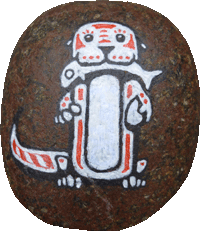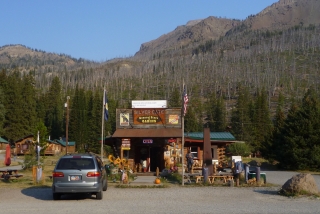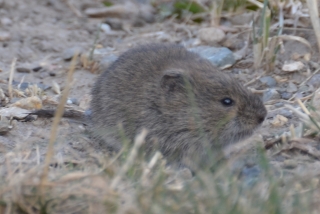21st September 2012
Last night and tonight we’re staying at Silvergate Cabins, just outside the park. My parents got unlucky; their cabin has mice, who came out at night to eat their hot chocolate and poo on the table. We have a colony of sagebrush voles outside our cabin; they’re sweet little things and don’t seem interested in breaking and entering. The guys who run the cabins have been helpful, lending us a spotting scope for free today (ought to be $30 rental) and giving us tips on where to look for wildlife.
We’re gradually grinding ourselves down with the wildlife watching, of course. Getting out on the road at 6:30 every morning to look for wildlife in the best hours (the two or three around dawn), then spending the day exploring and doing a hike somewhere in the park in the heat of the afternoon sun means that by about 7pm we’re wanting to just eat some dinner and fall into bed. Come tomorrow we leave Yellowstone for ranching country, and more sensible breakfast hours. So we had one last drive out this morning and got an excellent sighting of a family of moose among the willows by the creek. When that happens the 6:30 start is worth it. When it doesn’t happen, it’s hard to look forward to the next 6:30!
Silvergate is an odd place. You’ve got lots of people terrifically enthusiastic about wildlife watching, photography, enjoying the beauty of nature. And yet the whole place, and indeed the same people, are also part of and catering for the hunting fraternity. Of course Silvergate is a great place for hunters. Why? Well, it’s right outside Yellowstone so of course much richer in wildlife than all those other areas of wilderness that have been mostly hunted out. The hunters are just waiting for some poor sucker to stray out of the protective boundary of the National Park.
I should explain that there’s a strict permit system, so in any given year only X permits to hunt bull moose would be issued, based on research into population-size, in theory making it a sustainable activity. If that’s true, if they really have a thoroughly researched and completely understood grasp of the current population of these animals and the various other factors affecting the population’s stability, then that’s great. I’ll accept it’s sustainable. On a personal level, I don’t see the killing of animals purely for sport as an activity any civilised 21st century human should be interested in. But as I say, if it really isn’t a threat to any of these hunted species, then I’m not going to get militant about someone else’s lifestyle choice.
Related Images:















































